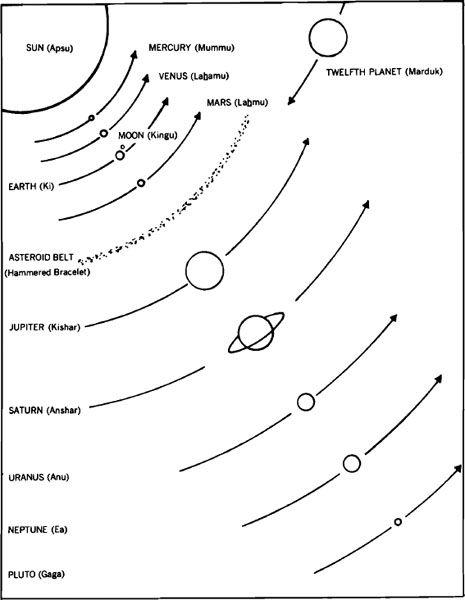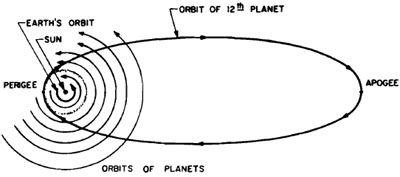The 12th Planet (38 page)
Authors: Zecharia Sitchin
Tags: #Non-Fiction, #Gnostic Dementia, #Fringe Science, #Retail, #Archaeology, #Ancient Aliens, #History

Indeed he did. He eliminated from the heavens the Sun's first partner-in-Creation, Tiamat. He brought Earth into being, thrusting it into a new orbit nearer the Sun. He hammered a "bracelet" in the heavens-the asteroid belt that does separate the group of inner planets from the group of outer planets. He turned most of Tiamat's satellites into comets; her chief satellite, Kingu, he put into orbit around Earth to become the Moon. And he shifted a satellite of Saturn, Gaga, to become the planet Pluto, imparting to it some of Marduk's own orbital characteristics (such as a different orbital plane).
The puzzles of our solar system—the oceanic cavities upon Earth, the devastation upon the Moon, the reverse orbits of the comets, the enigmatic phenomena of Pluto—all are perfectly answered by the Mesopotamian Creation epic, as deciphered by us.
Having thus "constructed the stations" for the planets, Marduk took for himself "Station Nibiru," and "crossed the heavens and surveyed" the
new
solar system. It was now made up of twelve celestial bodies, with twelve Great Gods as their counterparts. (Fig. 110)

Fig. 110
8
•
KINGSHIP OF HEAVEN
Studies of the "Epic of Creation" and parallel texts (for example, S. Langdon's
The Babylonian Epic of Creation)
show that sometime after 2000
B.C.
, Marduk, son of Enki, was the successful winner of a contest with Ninurta, son of Enlil, for supremacy among the gods. The Babylonians then revised the original Sumerian "Epic of Creation," expunged from it all references to Ninurta and most references to Enlil, and renamed the invading planet Marduk.
The actual elevation of Marduk to the status of "King of the Gods" upon Earth was thus accompanied by assigning to him, as his celestial counterpart, the planet of the Nefilim, the Twelfth Planet. As "Lord of the Celestial Gods [the planets]" Marduk was thus also "King of the Heavens."
Some scholars at first believed that "Marduk" was either the North Star or some other bright star seen in the Mesopotamian skies at the time of the spring equinox because the celestial Marduk was described as a "bright heavenly body." But Albert Schott
(Marduk und sein Stern)
and others have shown conclusively that all the ancient astronomical texts spoke of Marduk as a member of the solar system.
Since other epithets described Marduk as the "Great Heavenly Body" and the "One Who Illumines," the theory was advanced that Marduk was a Babylonian Sun God, parallel to the Egyptian god Ra, whom the scholars also considered a Sun God. Texts describing Marduk as he "who scans the heights of the distant heavens ... wearing a halo whose brilliance is awe-inspiring" appeared to support this theory. But the same text continued to say that "he surveys the lands like Shamash [the Sun]." If Marduk was in some respects
akin
to the Sun, he could not, of course,
be
the Sun.
If Marduk was not the Sun, which one of the planets was he? The ancient astronomical texts failed to fit anyone planet. Basing their theories on certain epithets (such as Son of the Sun), some scholars pointed at Saturn. The description of Marduk as a reddish planet made Mars, too, a candidate. But the texts placed Marduk in
markas shame
("in the center of Heaven"), and this convinced most scholars that the proper identification should be Jupiter, which is located in the center of the line of planets:
| | | | | Jupiter | | | | |
| Mercury | Venus | Earth | Mars | | Saturn | Uranus | Neptune | Pluto |
This theory suffers from a contradiction. The same scholars who put it forward were the ones who held the view that the Chaldeans were unaware of the planets beyond Saturn. These scholars list Earth as a planet, while contending that the Chaldeans thought of Earth as a flat center of the planetary system. And they omit the Moon, which the Mesopotamians most definitely counted among the "celestial gods." The equating of the Twelfth Planet with Jupiter simply does not work out.
The "Epic of Creation" clearly states that Marduk was an invader from outside the solar system, passing by the outer planets (including Saturn and Jupiter) before colliding with Tiamat. The Sumerians called the planet NIBIRU, the "planet of crossing," and the Babylonian version of the epic retained the following astronomical information:
Planet NIBIRU:
The Crossroads of Heaven and Earth he shall occupy.
Above and below, they shall not go across;
They must await him.
Planet NIBIRU:
Planet which is brilliant in the heavens.
He holds the central position;
To him they shall pay homage.
Planet NIBIRU:
It is he who without tiring
The midst of Tiamat keeps crossing.
Let "CROSSING" be his name-
The one who occupies the midst.
These lines provide the additional and conclusive information that in dividing the other planets into two equal groups, the Twelfth Planet in "the midst of Tiamat keeps crossing": Its orbit takes it again and again to the site of the celestial battle, where Tiamat used to be.
We find that astronomical texts that dealt in a highly sophisticated manner with the planetary periods, as well as lists of planets in their celestial order, also suggested that Marduk appeared somewhere between Jupiter and Mars. Since the Sumerians did know of all the planets, the appearance of the Twelfth Planet in "the central position" confirms our conclusions:
| | | | | | Mraduk | | | | | |
| Mercury | Venus | Moon | Earth | Mars | | Jupiter | Saturn | Uranus | Neptune | Pluto |
If Marduk's orbit takes it to where Tiamat once was, relatively near us (between Mars and Jupiter), why have we not yet seen this planet, which is supposedly large and bright?
The Mesopotamian texts spoke of Marduk as reaching unknown regions of the skies and the far reaches of the universe. "He scans the hidden knowledge ... he sees all the quarters of the universe." He was described as the "monitor" of all the planets, one whose orbit enables him to encircle all the others. "He keeps hold on their bands [orbits]," makes a "hoop" around them. His orbit was "loftier" and "grander" than that of any other planet. It thus occurred to Franz Kugler
(Sternkunde und Sterndienst in Babylon)
that Marduk was a fast-moving celestial body, orbiting in a great elliptical path just like a comet.
Such an elliptical path, focused on the Sun as a center of gravity, has an apogee—the point farthest from the Sun, where the return flight begins—and a perigee—the point nearest the Sun, where the return to outer space begins. We find that two such "bases" are indeed associated with Marduk in the Mesopotamian texts. The Sumerian texts described the planet as going from AN.UR ("Heaven's base") to E.NUN ("lordly abode"). The Creation epic said of Marduk:
He crossed the Heaven and surveyed the regions....
The structure of the Deep the Lord then measured.
E-Shara
he established as his outstanding abode;
E-Shara
as a great abode in the Heaven he established.
One "abode" was thus "outstanding"—far in the deep regions of space. The other was established in the "Heaven," within the asteroid belt, between Mars and Jupiter. (Fig.111)
Following the teachings of their Sumerian forefather, Abraham of Ur, the ancient Hebrews also associated their supreme deity with the supreme planet. Like the Mesopotamian texts, many books of the Old Testament describe the "Lord" has having his abode in the "heights of Heaven," where he "beheld the foremost planets as they were arisen"; a celestial Lord who, unseen, "in the heavens moves about in a circle." The Book of Job, having described the celestial collision, contains these significant verses telling us where the lordly planet had gone:

Fig. 111
Upon the Deep he marked out an orbit;
Where light and darkness [merge]
Is his farthest limit.
No less explicitly, the Psalms outlined the planet's majestic course:
The Heavens bespeak the glory of the Lord;
The Hammered Bracelet proclaims his handiwork....
He comes forth as a groom from the canopy;
Like an athlete he rejoices to run the course.
From the end of heavens he emanates,
And his circuit is to their end.
Recognized as a great traveler in the heavens, soaring to immense heights at its apogee and then "coming down, bowing unto the Heaven" at its perigee, the planet was depicted as a Winged Globe.
Wherever archaeologists uncovered the remains of Near Eastern peoples, the symbol of the Winged Globe was conspicuous, dominating temples and palaces, carved on rocks, etched on cylinder seals, painted on walls. It accompanied kings and priests, stood above their thrones, "hovered" above them in battle scenes, was etched into their chariots. Clay, metal, stone, and wood objects were adorned with the symbol. The rulers of Sumer and Akkad, Babylon and Assyria, Elam and Urartu, Mari and Nuzi, Mitanni and Canaan—all revered the symbol. Hittite kings, Egyptian pharaohs, Persian
shar's
—
all
proclaimed the symbol (and what it stood for) supreme. It remained so for millennia. (Fig. 112)
Central to the religious beliefs and astronomy of the ancient world was the conviction that the Twelfth Planet, the "Planet of the Gods," remained within the solar system and that its grand orbit returned it periodically to Earth's vicinity. The pictographic sign for the Twelfth Planet, the "Planet of Crossing," was a cross. This cuneiform sign, , which also meant "Anu" and "divine," evolved in the Semitic languages to the letter
, which also meant "Anu" and "divine," evolved in the Semitic languages to the letter
tav, which meant "the sign."
which meant "the sign."
